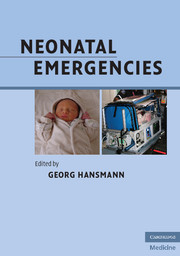Book contents
- Frontmatter
- Contents
- List of contributors
- Foreword (1)
- Foreword (2)
- Preface
- Acknowledgments
- Section 1 Organization of neonatal transport
- Section 2 Basics in cardiopulmonary resuscitation of newborn infants
- Section 3 Classic and rare scenarios in the neonatal period
- Management of healthy, term newborn infants (vaginal delivery, cesarean section, vacuum extraction, forceps delivery)
- Management of preterm and moderately depressed term newborn infants with a birth weight ≥1500 g
- Management of very preterm newborn infants (VLBW, ELBW)
- Twin–twin (feto–fetal) transfusion syndrome
- An apparently trivial call from the term baby nursery
- Out of hospital birth
- Hypoglycemia
- Meconium aspiration
- Chorioamnionitis and early-onset sepsis in the newborn infant
- Perinatal hemorrhage
- Perinatal hypoxia-ischemia
- Cerebral seizures
- Infants born to mothers on psychoactive substances
- Prenatal and postnatal arrhythmias
- Critical congenital cardiovascular defects
- Patent ductus arteriosus of the preterm infant
- Persistent pulmonary hypertension of the newborn (PPHN)
- Congenital diaphragmatic hernia
- Pneumothorax
- Congenital cystic adenomatoid malformation of the lung (CAM, CCAM)
- Chylothorax
- Hemolytic disease of the newborn
- Hydrops fetalis
- Choanal atresia
- Esophageal atresia
- Gastrointestinal obstruction
- Necrotizing enterocolitis (NEC)
- Omphalocele and gastroschisis
- Neural tube defects
- Cleft palate
- Birth trauma: brachial plexus palsy, facial nerve palsy, clavicular fracture, skull fracture, intracranial and subperiosteal hemorrhage (cephalohematoma)
- Sudden infant death syndrome (SIDS)
- Questions for review
- References (Section 3)
- Section 4 Transport
- Section 5 Appendix
- Index
- Plate section
Persistent pulmonary hypertension of the newborn (PPHN)
from Section 3 - Classic and rare scenarios in the neonatal period
Published online by Cambridge University Press: 05 March 2012
- Frontmatter
- Contents
- List of contributors
- Foreword (1)
- Foreword (2)
- Preface
- Acknowledgments
- Section 1 Organization of neonatal transport
- Section 2 Basics in cardiopulmonary resuscitation of newborn infants
- Section 3 Classic and rare scenarios in the neonatal period
- Management of healthy, term newborn infants (vaginal delivery, cesarean section, vacuum extraction, forceps delivery)
- Management of preterm and moderately depressed term newborn infants with a birth weight ≥1500 g
- Management of very preterm newborn infants (VLBW, ELBW)
- Twin–twin (feto–fetal) transfusion syndrome
- An apparently trivial call from the term baby nursery
- Out of hospital birth
- Hypoglycemia
- Meconium aspiration
- Chorioamnionitis and early-onset sepsis in the newborn infant
- Perinatal hemorrhage
- Perinatal hypoxia-ischemia
- Cerebral seizures
- Infants born to mothers on psychoactive substances
- Prenatal and postnatal arrhythmias
- Critical congenital cardiovascular defects
- Patent ductus arteriosus of the preterm infant
- Persistent pulmonary hypertension of the newborn (PPHN)
- Congenital diaphragmatic hernia
- Pneumothorax
- Congenital cystic adenomatoid malformation of the lung (CAM, CCAM)
- Chylothorax
- Hemolytic disease of the newborn
- Hydrops fetalis
- Choanal atresia
- Esophageal atresia
- Gastrointestinal obstruction
- Necrotizing enterocolitis (NEC)
- Omphalocele and gastroschisis
- Neural tube defects
- Cleft palate
- Birth trauma: brachial plexus palsy, facial nerve palsy, clavicular fracture, skull fracture, intracranial and subperiosteal hemorrhage (cephalohematoma)
- Sudden infant death syndrome (SIDS)
- Questions for review
- References (Section 3)
- Section 4 Transport
- Section 5 Appendix
- Index
- Plate section
Summary
Definition
Persistent pulmonary hypertension of the newborn (PPHN) is a syndrome resulting from maladaptation to extrauterine life without a sustained normalization of pulmonary vascular resistance (PVR). PPHN is characterized by an elevation in PVR with resultant hypoxemia due to right-to-left shunting at the ductal and/or atrial level. PPHN may be confused with, or may coexist with, congenital heart disease: PPHN is frequently idiopathic but may be associated with respiratory failure/alveolar hypoxia (e.g., meconium aspiration syndrome, congenital pneumonia, sepsis, birth asphyxia, respiratory distress syndrome (RDS)), lung hypoplasia (e.g., congenital diaphragmatic hernia, alveolar capillary dysplasia) and maternal medication (e.g., late gestational use of selective serotonin reuptake inhibitors (SSRI); see Table 3.8).
Syndrome
Persistent fetal circulation (PFC) is used rarely.
Epidemiology
Incidence 0.67/1000 to 1.9/1000 live births. The risk of PPHN is about sixfold increased in newborns whose mothers used antidepressants of the SSRI class (e.g., Prozac®) after 20 weeks of gestation, with an overall incidence of approx. 6 to 12 per 1000 exposed women. However, the latter risk increase is based on a retrospective case controlled study with a very small effect size, i.e., 99% of women exposed to SSRI will have a baby not affected by PPHN. The incidence of “idiopathic” PPHN in neonates with Down syndrome (trisomy 21) is high (≈12/1000), but in the absence of associated conditions there is resolution of PPHN.
Etiology/pathophysiology
See also p. 63 “Postnatal cardiopulmonary adaptation”
[…]
- Type
- Chapter
- Information
- Neonatal Emergencies , pp. 392 - 403Publisher: Cambridge University PressPrint publication year: 2009



